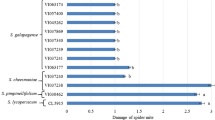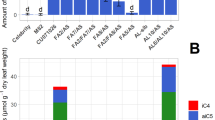Abstract
Trichome-based host plant resistance is a complex mechanism that could be used in tomato breeding to control arthropod pests. The aims of this work were to evaluate the plant traits (density of trichomes and acylsucrose production) and the functional relationships of these traits with mortality, repellence, and oviposition of Tetranychus urticae Koch (Acari: Tetranychidae). We used a population of recombinant inbred lines (RILs) derived from the cross between the wild tomato, Solanum pimpinellifolium L. ‘TO-937’, and the cultivated tomato, Solanum lycopersicum L. Multiple regression analyses showed that high acylsucrose content and high type-IV trichome density increased mortality and repellence, and reduced oviposition of T. urticae. Single regression analyses showed that a logistic model best explained the relationship between mortality or repellence and acylsucrose content, whereas a negative-exponential model best described the relationship between oviposition and acylsucrose content. Linear models were the best-fits for the three resistance variables with trichome IV density. Probit analysis was used to estimate acylsucrose effective doses, and revealed that 31 and 10% of the RILs produced acylsucrose above the effective doses for 90% mortality or repellence, respectively. Altogether, these results indicate that S. pimpinellifolium may be a suitable genetic source of resistance to spider mites to be used in cultivated tomato.



Similar content being viewed by others
References
Berlinger MJ (1986) Pests. In: Atherton JG, Rudich J (eds) The tomato crop: a scientific basis for improvement. Chapman and Hall, New York, pp 391–441
Burke BA, Goldsby G, Mudd JB (1987) Polar epicuticular lipids of Lycopersicon pennellii. Phytochemistry 26:2567–2571. doi:10.1016/S0031-9422(00)83879-0
Carter CD, Snyder JC (1981) Leaf trichomes and mite resistance of Lycopersicon esculentum and L. hirsutum. HortScience 16:400
Carter CD, Snyder JC (1985) Mite responses in relation to trichomes of Lycopersicon esculentum × L. hirsutum F2 hybrids. Euphytica 34:177–185. doi:10.1007/BF00022877
Channarayappa, Shivashankar G, Muniyappa V, Frist RH (1992) Resistance of Lycopersicon species to Bemisia tabaci, a tomato leaf curl virus vector. Can J Bot 70:2184–2192. doi:10.1139/b92-270
Chatzivasileiadis EA, Sabelis MW (1997) Toxicity of methyl ketones from tomato trichomes to Tetranychus urticae Koch. Exp Appl Acarol 21:473–484. doi:10.1023/A:1018436113892
Chatzivasileiadis EA, Boon JJ, Sabelis MW (1999) Accumulation and turnover of 2-tridecanone in Tetranychus urticae and its consequences for resistance of wild and cultivated tomatoes. Exp Appl Acarol 23:1011–1021. doi:10.1023/A:1006394109643
de Azevedo SM, Faria MV, Maluf WR, de Oliveira ACB, de Freitas JA (2003) Zingiberene-mediated resistance to the South American tomato pinworm derived from Lycopersicon hirsutum var. hirsutum. Euphytica 134:347–351. doi:10.1023/B:EUPH.0000005007.14924.d2
de Resende JT, Maluf WR, Cardoso MG, Faria MV, Gonçalves LD, do Nascimento IR (2008) Resistance of tomato genotypes with high level of acylsugars to Tetranychus evansi Baker and Pritchard. Sci Agric 65:31–35
Fernández-Muñoz R, Domínguez E, Cuartero J (2000) A novel source of resistance to the two-spotted spider mite in Lycopersicon pimpinellifolium (Jusl.) Mill.: its genetics as affected by interplot interference. Euphytica 111:169–173. doi:10.1023/A:1003893432676
Fernández-Muñoz R, Salinas M, Álvarez M, Cuartero J (2003) Inheritance of resistance to two-spotted spider mite and glandular leaf trichomes in wild tomato Lycopersicon pimpinellifolium (Jusl.) Mill. J Am Soc Hortic Sci 128:188–195
Freitas JA, Maluf WR, Cardoso MD, Gomes LAA, Bearzotti E (2002) Inheritance of foliar zingiberene contents and their relationship to trichome densities and whitefly resistance in tomatoes. Euphytica 127:275–287. doi:10.1023/A:1020239512598
Goffreda JC, Mutschler MA (1987) Potato aphid feeding response to Lycopersicon pennellii type IV trichome exudate and trichome exudate components. HortScience 22:1073
Goffreda JC, Steffens JC, Mutschler MA (1990) Association of epicuticular sugars with aphid resistance in hybrids with wild tomato. J Am Soc Hortic Sci 115:161–165
Guo ZH, Weston PA, Snyder JC (1993) Repellency to 2-spotted spider-mite, Tetranychus urticae Koch, as related to leaf surface chemistry of Lycopersicon hirsutum accessions. J Chem Ecol 19:2965–2979. doi:10.1007/BF00980596
Gurr GM, McGrath D (2001) Effect of plant variety, plant age and photoperiod on glandular pubescence and host-plant resistance to potato moth (Phthorimaea operculella) in Lycopersicon spp. Ann Appl Biol 138:221–230. doi:10.1111/j.1744-7348.2001.tb00106.x
Gurr GM, McGrath D (2002) Foliar pubescence and resistance to potato moth, Phthorimaea operculella, in Lycopersicon hirsutum. Entomol Exp Appl 103:35–41. doi:10.1023/A:1019819722203
Hawthorne DJ, Shapiro JA, Tingey WM, Mutschler MA (1992) Trichome-borne and artificially applied acylsugars of wild tomato deter feeding and oviposition of the leafminer Liriomyza trifolii. Entomol Exp Appl 65:65–73. doi:10.1007/BF00189718
Hosmer DW, Lemeshow S (2000) Introduction to the logistic regression model. Applied logistic regression. Wiley, New York, pp 1–30
Johnson R (1992) Past, present, and future opportunities in breeding for disease resistance, with examples from wheat. Euphytica 63:3–22. doi:10.1007/BF00023908
Juvik JA, Shapiro JA, Young TE, Mutschler MA (1994) Acylglucoses from wild tomatoes alter behavior and reduce growth and survival of Helicoverpa zea and Spodoptera exigua (Lepidoptera: Noctuidae). J Econ Entomol 87:482–492
Leite GLD, Picanco M, Della Lucia TMC, Moreira MD (1999) Role of canopy height in the resistance of Lycopersicon hirsutum f. glabratum to Tuta absoluta (Lep: Gelechiidae). J Appl Entomol 123:459–463. doi:10.1046/j.1439-0418.1999.00385.x
Leite GLD, Picanco M, Guedes RNC, Zanuncio JC (2001) Role of plant age in the resistance of Lycopersicon hirsutum f. glabratum to the tomato leafminer Tuta absoluta (Lepidoptera: Gelechiidae). Sci Hortic (Amsterdam) 89:103–113. doi:10.1016/S0304-4238(00)00224-7
Liedl BE, Lawson DM, White KK, Shapiro JA, Cohen DE, Carson WG, Trumble JT, Mutschler MA (1995) Acylsugars of wild tomato Lycopersicon pennellii alters settling and reduces oviposition of Bemisia argentifolii (Homoptera: Aleyrodidae). J Econ Entomol 88:742–748
Luckwill LC (1943) The genus Lycopersicon. An historical, biological, and taxonomic survey of the wild and cultivated tomatoes. Aberdeen Univ. Stud. No. 120
Maliepaard C, Bas N, van Heusden S, Kos J, Pet G, Verkerk R et al (1995) Mapping of QTLs for glandular trichome densities and Trialeurodes vaporariorum (greenhouse whitefly) resistance in an F2 from Lycopersicon esculentum × Lycopersicon hirsutum f. glabratum. Heredity 75:425–433. doi:10.1038/hdy.1995.155
Maluf WR, Barbosa LV, SantaCecilia LVC (1997) 2-Tridecanone-mediated mechanisms of resistance to the South American tomato pinworm Scrobipalpuloides absoluta (Meyrick, 1917) (Lepidoptera: Gelechiidae) in Lycopersicon spp. Euphytica 93:189–194. doi:10.1023/A:1002963623325
Maluf WR, Campos GA, Cardoso MD (2001) Relationships between trichome types and spider mite (Tetranychus evansi) repellence in tomatoes with respect to foliar zingiberene contents. Euphytica 121:73–80. doi:10.1023/A:1012067505361
Nelson N (1944) A photometric adaptation of the Somogyi method for the determination of glucose. J Biol Chem 153:375–380
Nihoul P (1993) Do light intensity, temperature and photoperiod affect the entrapment of mites on glandular hairs of cultivated tomatoes? Exp Appl Acarol 17:709–718. doi:10.1007/BF00058510
Nihoul P (1994) Phenology of glandular trichomes related to entrapment of Phytoseiulus persimilis A–H in the glasshouse tomato. J Hortic Sci 69:783–789
Puterka GJ, Farone W, Palmer T, Barrington A (2003) Structure-function relationships affecting the insecticidal and miticidal activity of sugar esters. J Econ Entomol 96:636–644
Rick CM (1979) Biosystematic studies in Lycopersicon and closely related species of Solanum. In: Hawkes JG, Lester RN, Skelding AD (eds) The biology, taxonomy of the Solanaceae. Academic, New York, pp 667–678
Saeidi Z, Mallik B, Kulkarni RS (2007) Inheritance of glandular trichomes and two-spotted spider mite resistance in cross Lycopersicon esculentum ‘Nandi’ and L. pennellii ‘LA2963’. Euphytica 154:231–238. doi:10.1007/s10681-006-9291-4
Simmons AT, Gurr GM (2005) Trichomes of Lycopersicon species and their hybrids: effects on pests and natural enemies. Agric For Entomol 7:265–276. doi:10.1111/j.1461-9555.2005.00271.x
Simmons AT, Nicol HI, Gurr GM (2006) Resistance of wild Lycopersicon species to the potato moth Phthorimaea operculella (Zeller) (Lepidoptera: Gelechiidae). Aust J Entomol 45:81–86. doi:10.1111/j.1440-6055.2006.00501.x
Snyder JC, Simmons AM, Thacker RR (1998) Attractancy and ovipositional response of adult Bemisia argentifolii (Homoptera: Aleyrodidae) to type IV trichome density on leaves of Lycopersicon hirsutum grown in three day-length regimes. J Entomol Sci 33:270–281
Somogyi M (1952) Notes on sugar determination. J Biol Chem 195:19–23
Van Haren RJF, Steenhuis MM, Sabelis MW, Deponti OMB (1987) Tomato stem trichomes and dispersal success of Phytoseiulus persimilis relative to its prey Tetranychus urticae. Exp Appl Acarol 3:115–121. doi:10.1007/BF01270473
Wagner GJ, Wang E, Shepherd RW (2004) New approaches for studying and exploiting an old protuberance, the plant trichome. Ann Bot (Lond) 93:3–11. doi:10.1093/aob/mch011
Weston PA, Snyder JC (1990) Thumbtack bioassay: a quick method for measuring plant-resistance to 2-spotted spider-mites (Acari: Tetranychidae). J Econ Entomol 83:500–504
Wilkens RT, Shea GO, Halbreich S, Stamp NE (1996) Resource availability and the trichome defenses of tomato plants. Oecologia 106:181–191. doi:10.1007/BF00328597
Williams WG, Kennedy GG, Yamamoto RT, Thacker JD, Bordner J (1980) 2-Tridecanone: a naturally occurring insecticide from the wild tomato Lycopersicon hirsutum f. glabratum. Science 207:888–889. doi:10.1126/science.207.4433.888
Acknowledgments
This study is part of the research projects AGL2004-06985-C02-01 and AGL2007-66760-C02-02, co-funded by the Ministerio de Educación y Ciencia (MEC, Spain) and the Fondo Europeo de Desarrollo Regional (FEDER, EU). J.M.A. was a recipient of a pre-doctoral I3P fellowship from CSIC-Fondo Social Europeo. M.M. was employed by the CSIC within the framework of a post-doctoral JAE position. We thank three anonymous reviewers for their useful comments.
Author information
Authors and Affiliations
Corresponding author
Rights and permissions
About this article
Cite this article
Alba, J.M., Montserrat, M. & Fernández-Muñoz, R. Resistance to the two-spotted spider mite (Tetranychus urticae) by acylsucroses of wild tomato (Solanum pimpinellifolium) trichomes studied in a recombinant inbred line population. Exp Appl Acarol 47, 35–47 (2009). https://doi.org/10.1007/s10493-008-9192-4
Received:
Accepted:
Published:
Issue Date:
DOI: https://doi.org/10.1007/s10493-008-9192-4




